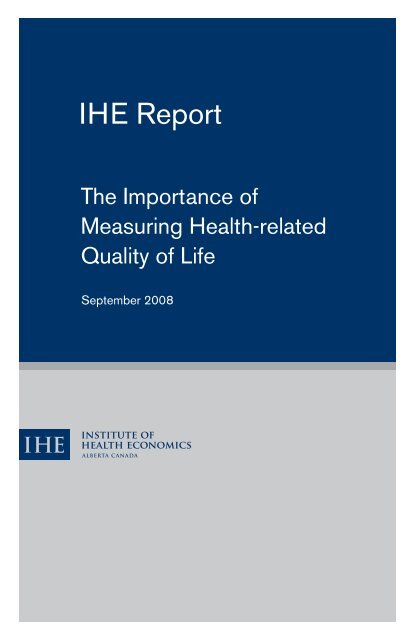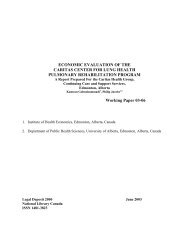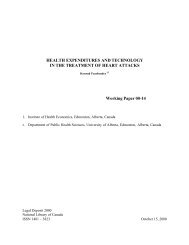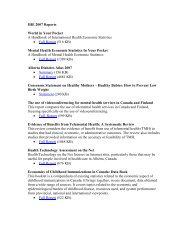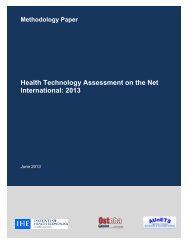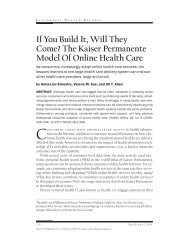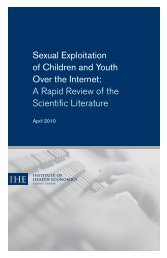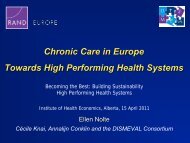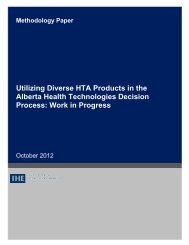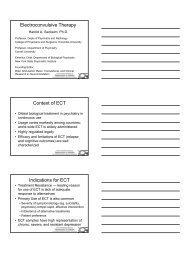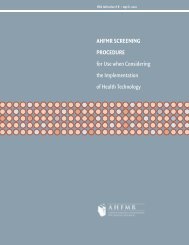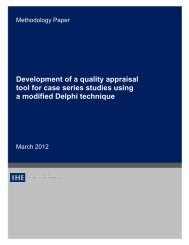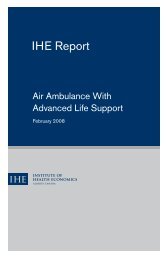IHE Report - Institute of Health Economics
IHE Report - Institute of Health Economics
IHE Report - Institute of Health Economics
- No tags were found...
Create successful ePaper yourself
Turn your PDF publications into a flip-book with our unique Google optimized e-Paper software.
<strong>IHE</strong> <strong>Report</strong>The Importance <strong>of</strong>Measuring <strong>Health</strong>-relatedQuality <strong>of</strong> LifeSeptember 2008
<strong>Institute</strong> <strong>of</strong> <strong>Health</strong> <strong>Economics</strong>The <strong>Institute</strong> <strong>of</strong> <strong>Health</strong> <strong>Economics</strong> (<strong>IHE</strong>) is an independent, not-for-pr<strong>of</strong>itorganization that performs research in health economics and synthesizesevidence in health technology assessment to assist health policy makingand best medical practices.<strong>IHE</strong> Board <strong>of</strong> DirectorsChairDr. Lorne Tyrrell - Chair, <strong>Institute</strong> <strong>of</strong> <strong>Health</strong> <strong>Economics</strong> and Pr<strong>of</strong>essorand CIHR/GSK Chair in Virology, University <strong>of</strong> AlbertaGovernmentMs. Linda Miller - Acting Deputy Minister, Alberta <strong>Health</strong> and WellnessMs. Annette Trimbee - Deputy Minister, Advanced Education and TechnologyDr. Bill McBlain - Senior Associate Vice President (Research), University <strong>of</strong> Alberta,and Interim Vice President, Research, Capital <strong>Health</strong>Dr. Chris Eagle - Executive Vice President and Chief Clinical Officer, Calgary <strong>Health</strong> RegionDr. Jacques Magnan -Acting President and CEO, Alberta Heritage Foundationfor Medical ResearchAcademiaDr. Tom Feasby - Dean, Faculty <strong>of</strong> Medicine, University <strong>of</strong> CalgaryDr. Franco Pasutto - Dean, Faculty <strong>of</strong> Pharmacy and Pharmaceutical Sciences,University <strong>of</strong> AlbertaDr. Herb Emery - Pr<strong>of</strong>essor, Department <strong>of</strong> <strong>Economics</strong>, University <strong>of</strong> CalgaryDr. Andy Greenshaw - Associate Vice President (Research), University <strong>of</strong> AlbertaDr. Rose Goldstein - Vice President (Research), University <strong>of</strong> CalgaryDr. Andre Plourde - Chair, Department <strong>of</strong> <strong>Economics</strong>, University <strong>of</strong> AlbertaIndustryMr. Ge<strong>of</strong>frey Mitchinson - Vice President, Public Affairs, GlaxoSmithKline Inc.Mr. Gregg Szabo - Vice President, Corporate Affairs, Merck Frosst Canada Ltd.Mr. Terry McCool - Vice President, Corporate Affairs, Eli Lilly Canada Inc.Mr. William Charnetski - Vice President, Corporate Affairs and General Counsel,AstraZeneca Canada Inc.Dr. Bernard Prigent - Vice President & Medical Director, Pfizer Canada Inc.OtherMr. Doug Gilpin - Chair, Audit and Finance CommitteeCEODr. Egon Jonsson - Executive Director and CEO, <strong>Institute</strong> <strong>of</strong> <strong>Health</strong> <strong>Economics</strong>,Pr<strong>of</strong>essor, University <strong>of</strong> Alberta, University <strong>of</strong> CalgaryBoard SecretaryJohn Sproule - Senior Policy Director, <strong>Institute</strong> <strong>of</strong> <strong>Health</strong> <strong>Economics</strong>
ACKNOWLEDGMENTSThe authors acknowledge the comments and suggestions providedby Pr<strong>of</strong>. George Torrance PhD., Emeritus Pr<strong>of</strong>essor, McMaster University,Ontario, Canada and <strong>Health</strong> Utilities Incorporated, Dundas, Ontario,Canada on an earlier draft <strong>of</strong> the paper. The authors also acknowledgethe contributions <strong>of</strong> the authors <strong>of</strong> <strong>Institute</strong> <strong>of</strong> <strong>Health</strong> <strong>Economics</strong> studieson health-related quality <strong>of</strong> life reviewed in this monograph.iiThe Importance <strong>of</strong> Measuring <strong>Health</strong>-related Quality <strong>of</strong> Life
TABLE OF CONTENTSIntroduction .................................................1History .....................................................1Definitions ..................................................2<strong>Health</strong> ................................................2<strong>Health</strong>-related Quality <strong>of</strong> Life ............................3Why Measure <strong>Health</strong>-related Quality <strong>of</strong> Life? ....................3Which Measure to Use? .......................................3Purpose <strong>of</strong> the Measure. .................................4Properties .............................................4Clinically Important Differences ..........................5Types <strong>of</strong> Measures ......................................6Comparison <strong>of</strong> Measures ................................8Assessing <strong>Health</strong>-related Quality <strong>of</strong> Life in RoutineClinical Care <strong>of</strong> Chronically Ill Patients ..........................9Summary ..................................................11<strong>Health</strong>-related Quality <strong>of</strong> Life studies Conductedat the <strong>Institute</strong> <strong>of</strong> <strong>Health</strong> <strong>Economics</strong> ...........................11Appendix ..................................................15Table 1. Summary Information on <strong>Health</strong>-relatedQuality <strong>of</strong> Life Measures. ...............................15Table 2. Abbreviations, Full names and Referencesfor <strong>Health</strong>-related Quality <strong>of</strong> Life Measures Describedin Table ..............................................19References .................................................19The Importance <strong>of</strong> Measuring <strong>Health</strong>-related Quality <strong>of</strong> Lifeiii
INTRODUCTION<strong>Health</strong>-related quality <strong>of</strong> life (HRQL) measures have been widely used inhealth research in recent years and have been the endpoint in many clinicalstudies. This trend reflects the recognition that many treatments for chronicdiseases fail to provide a cure and that the benefits <strong>of</strong> therapy may be limited.In some circumstances, the clinical therapeutic benefits may be outweighedby HRQL considerations. In addition, patients are interested in knowing theeffect <strong>of</strong> a therapy on their HRQL. Patient advocacy groups have called forprovision <strong>of</strong> comprehensive information about the consequences <strong>of</strong> the diseaseand treatment on the daily lives <strong>of</strong> patients. Funding bodies, agencies and ethicsreview committees have also become interested in HRQL assessments andhave encouraged the use <strong>of</strong> HRQL measures in clinical studies.Nonetheless incorporating HRQL assessments into clinical research representa challenge. This monograph provides an overview <strong>of</strong> HRQL measurementto facilitate an understanding <strong>of</strong> HRQL measures to be used in both clinicalpractice and research. Clinicians <strong>of</strong> all disciplines may find this monographuseful in guiding their selection <strong>of</strong> HRQL measures for use in their clinicalpractice and research programs. The monograph also provides a brief summary<strong>of</strong> HRQL studies conducted at the <strong>Institute</strong> <strong>of</strong> <strong>Health</strong> <strong>Economics</strong>.HISTORYIn contemporary society most people are familiar with the term “Quality<strong>of</strong> Life”. However, it may have different meanings to different people. Is ithappiness? Is it absence <strong>of</strong> disease? Is it satisfaction with life?For many years attempts have been made to define Quality <strong>of</strong> Life (QoL).Probably one <strong>of</strong> the first definitions <strong>of</strong> QoL appears in the NichomacheanEthics. Aristotle (384–322 BC) described QoL as both a state <strong>of</strong> feeling and akind <strong>of</strong> activity. He incorporated the idea <strong>of</strong> “being happy” and physical activityinto the definition <strong>of</strong> QoL. He also noted that QoL meant different things todifferent people and that it varied according to a person’s current situation.For example, the same man says different things at different times: “when hefalls sick he thinks health is happiness, when he is poor, wealth” (Fayers P. andMachin D. 2000, pg 5).Despite the numerous uses <strong>of</strong> the term QoL, the concept was not measureduntil the twentieth century. The earliest attempts to assess functional healthstatus in adults, as the ability to perform self-care and basic physical activities,was published in 1937 (Prutkin JM 2002). Ten years later, David Karn<strong>of</strong>skydeveloped a scale to evaluate the performance status <strong>of</strong> cancer patients inclinical settings. This scale ranges from 0 (dead) to 100 (normal, no complaints,no evidence <strong>of</strong> disease). The Karn<strong>of</strong>sky scale led to the development <strong>of</strong> TheIndex <strong>of</strong> Independence <strong>of</strong> Activities <strong>of</strong> Daily Living (Katz et al 1963) and the1The Importance <strong>of</strong> Measuring <strong>Health</strong>-related Quality <strong>of</strong> Life
Barthel Index (Mahoney and Barthel 1965). In 1957, the PULSES pr<strong>of</strong>ile waspublished (Moskowitz and McCann). It was derived from a pr<strong>of</strong>ile developedby the Canadian army to assess the functional status <strong>of</strong> new soldiers duringWorld War II. PULSES was probably the first functional status index toinclude mental and emotional status. Over the next two decades numerousQoL measures were developed including the Eastern Cooperative CancerChemotherapy Group in 1960 (Oken et al.1982) and the Sickness ImpactPr<strong>of</strong>ile in the 1970’s (Bergner et al 1981).QoL measures include different aspects <strong>of</strong> people’s perceptions about health.Some <strong>of</strong> the measures assessed the physical and emotional aspects, othersexamined the effects <strong>of</strong> treatment or disease, such as fatigue. Others adopteda holistic approach by including people’s beliefs.Parallel to these different approaches to measuring QoL are a variety <strong>of</strong>theoretical models (Fayers and Machin (2000)). The “expectations model”(Calman 1984) measures QoL as the difference between the hopes andexpectations <strong>of</strong> the individual and their current status/experience. This modelmay be related to a previous theory by Freud (1917) where he referred to“the gap” between the real self and the ideal self when assessing individualswith depression. The “needs model” describes QoL at its highest when allneeds are met and at its lowest when few needs are satisfied. Aspects such asidentity, self-esteem, affection, love, food, sleep, pain avoidance and activitywere considered as “needs”. The “existential approach” recognized by Aristotleincludes items such as pleasure in life and positive outlook. This model isimportant when assessing QoL in patients whose perceptions are influenced byexistential beliefs. The patient-preference utility model focuses on the value thatsubjects attach to various health status. Would you rather live with a chronicdisease for the rest <strong>of</strong> your life or would you prefer immediate death? Whenafter an accident the surgeon suggests a procedure with a 50:50 chance to die,would the patient take the risk? What is the patient’s preference? This modelis derived from utility and decision-making theory and is particularly useful ineconomic evaluation <strong>of</strong> healthcare services.To this point we had an idea <strong>of</strong> the historical development <strong>of</strong> the measures <strong>of</strong>QoL, but what is “<strong>Health</strong>”? What is health-related quality <strong>of</strong> life (HRQL)? Whymeasure HRQL?DEFINITIONSWhat is <strong>Health</strong>?The World <strong>Health</strong> Organization defines health as “a state <strong>of</strong> completephysical and mental and social well-being, and not merely the absence<strong>of</strong> disease or infirmity (Official Records <strong>of</strong> the World <strong>Health</strong> Organization,no. 2, p. 100 1948).The Importance <strong>of</strong> Measuring <strong>Health</strong>-related Quality <strong>of</strong> Life 2
What Is <strong>Health</strong>-related Quality <strong>of</strong> Life?There are many ways <strong>of</strong> defining HRQL; virtually all definitions suggest thathealth is a multidimensional concept. A variety <strong>of</strong> prominent definitions arelisted below.HRQL describes the physical, social, emotional aspects <strong>of</strong> an individualas they relate to their prior and current health state (Borgaonkar MR andIrvine EJ 2000, pg 444).HRQL is the value that an individual assigned to the duration <strong>of</strong> lifeas modified by impairments, functional states, perceptions and socialopportunities that are influenced by disease, injury, treatment or policy.(Patrick D and Erickson J 1993, pg 22).HRQL assessment describes health status from the patient’s perspectives.For example, two individuals with the same disease severity and medicaltreatment may react differently. One subject may be able to have a moreactive life, work full time, and enjoy family and social life. The other maybe depressed and unable to enjoy life.Overall, all these definitions include issues that are <strong>of</strong> relevance and importanceto the patient’s well-being.WHY MEASURE HRQL?HRQL measurements are important for assessing the impact <strong>of</strong> the chronicdisease and its treatment on patients. Traditionally, medical outcomes havebeen measured using objective clinical indicators (e.g. physiologic tests anddisease status). Recently, there has been a gradual shift toward includingevaluations <strong>of</strong> medical outcomes from the patient’s perspective.HRQL assessments are <strong>of</strong> use to clinicians and policy makers because they<strong>of</strong>fer a pr<strong>of</strong>ile <strong>of</strong> the current health status <strong>of</strong> an individual. This additionalinformation is valuable in helping to understand the wide variability inindividual responses to similar conditions. For example, two patients with thesame diagnosis and treatment may display different HRQL scores; one maycontinue to work whereas the other patient may quit his job. Administratorsare particularly interested in HRQL because the case mix <strong>of</strong> patients affectsuse and expenditure patterns, because increasing efforts exist to incorporateHRQLs as measures <strong>of</strong> the quality <strong>of</strong> care and <strong>of</strong> clinical effectiveness, andbecause payers are beginning to use HRQL information in reimbursementdecisions (Guyatt et al. 1993).WHICH IS THE “IDEAL HRQL MEASURE”?The choice <strong>of</strong> measure is a an important step in its application to clinicalresearch and care. There are several factors to consider when choosing aHRQL measure to be used in clinical research and/or routine clinical care.3The Importance <strong>of</strong> Measuring <strong>Health</strong>-related Quality <strong>of</strong> Life
This selection depends on the purpose <strong>of</strong> the measurement, type <strong>of</strong> measure,performance characteristics <strong>of</strong> the HRQL measures and other factors relevantto clinical practice.Main Purposes <strong>of</strong> HRQL measuresThe main purposes for which measures <strong>of</strong> HRQL are designed are:discrimination, evaluation and prediction. Distinguishing the burden <strong>of</strong>the illness between different groups or individuals at a point in time is anexample <strong>of</strong> discrimination. A measure would be useful for discriminativepurposes if it demonstrated substantial variability among subjects. Forinstance, in cardiovascular disease HRQL instruments could be used todistinguish between patients with severe and moderate burdens.Evaluation refers to the assessment <strong>of</strong> within-person change over time.Evaluative uses are generally found in randomized controlled trials andprospective studies. The aim <strong>of</strong> these studies is to assess change in health statuswithin individuals over-time. Items in the questionnaire need to reflect aspects <strong>of</strong>health status that are modifiable. The measure should be stable in stable patientsand it should capture meaningful change over time when it occurs. For example,has the patient’s HRQL improved after the heart transplant? Has the patient’soutcome improved after the use <strong>of</strong> HRQL measure in routine clinical care?Prediction refers to the ability <strong>of</strong> one measure to predict the score on anothermeasure or to predict future outcomes. Predictive measures taken at time tcan predict outcomes at time t +1. An example is the evidence that baselinemeasures have independent prognostic value for predicting survival in lungcancer, breast cancer and metastatic malignant melanoma. (Feeny et al. 1999).Prediction could also refer to estimation <strong>of</strong> the score <strong>of</strong> another measureat the same point in time. For example, we could use a shorter form <strong>of</strong> aquestionnaire, SF-12, as a substitute for a longer form, SF-36 (Ware et al 1992;Ware 1996).Properties <strong>of</strong> HRQL measuresIn addition to the purpose <strong>of</strong> the measure there are additional criteriato take into consideration in selecting a measure <strong>of</strong> HRQL.Acceptability: The measure should be acceptable to patients and cliniciansin the setting in which it will be used. For example, the <strong>Health</strong> Utilities IndexMark 3 (HUI3) should be appropriate for use at the adult cardiology clinic.Pilot studies are recommended to assess acceptability and obtain patientfeedback about the HRQL measures they complete.Burden: Burden includes the time for completion, degree <strong>of</strong> difficulty, anddegree <strong>of</strong> concentration <strong>of</strong> patients who complete instruments. Burden canalso include emotional upset. The burden to patients should be minimal.The Importance <strong>of</strong> Measuring <strong>Health</strong>-related Quality <strong>of</strong> Life 4
Reliability: A measure is reliable when it yields the same score after repeatedmeasurements in stable patients. Reliability can be assessed in differentways: intra-rater (test-retest), inter-rater and internal consistency. Test-retestis assessed when under the identical conditions the same rater repeats themeasure. Inter-rater reliability refers to the measurement that is made at thesame point in time by two or more raters and yields the same score. Internalconsistency among the items in a questionnaire refers to the relationshipamong the items administered at the same point in time, and is <strong>of</strong>tenmeasured by Cronbach’s alpha.Validity: A HRQL instrument is valid when it measures what it is supposed tomeasure. There are four types <strong>of</strong> validity: face, content, construct and criterionvalidity. Face validity is the extent to which the users and respondents findthe items included in the measure to be relevant. Content validity refers to therelevance <strong>of</strong> the items and domains included in the measure. Construct validityrefers to the extent to which a particular measure relates to other measuresin a way that is consistent with the theoretically derived hypotheses relatedto concepts that are being measured. Another approach is to compare scoresfor known groups either cross-sectionally or longitudinally. The assessment<strong>of</strong> construct validity involves the specification <strong>of</strong> a priori hypotheses and thetesting <strong>of</strong> those hypotheses. Finally, criterion validity involves the assessment<strong>of</strong> the relationship between the test measure and the criterion or gold standard.In general, in the field <strong>of</strong> HRQL, there is no gold standard and thus criterionvalidity is <strong>of</strong> limited use except for the evaluation <strong>of</strong> predictive validity.Responsiveness: A measure is responsive when it is able to capture changein a patient’s condition over time when it occurs. Some investigators use theterm longitudinal construct validity instead.Usefulness: Usefulness refers to the ability <strong>of</strong> the measure to influence decisionmaking including the management <strong>of</strong> individual patients, formulation <strong>of</strong> clinicalpolicy, and resource allocation. Does the use <strong>of</strong> the measure matter?Interpretability: Interpretability refers to the ability to assign meaning tothe scores yielded by the measure (quantitative or qualitative). Effectiveinterpretation <strong>of</strong> the results involves the accumulation <strong>of</strong> experience andevidence. Interpretation involves an idea <strong>of</strong> the magnitude <strong>of</strong> differencesor changes that are clinically important.What is the clinically important difference?“Is the smallest difference which patients perceive as beneficial and whichwould mandate, in the absence <strong>of</strong> troublesome side effects and excessive cost,a change in the patient’s management” (Jaeschke et al. 1989). At all levels, oneneeds to understand and explain HRQL differences in ways that are relevantto the health care decision at hand and to people involved in that decision.(Osoba D. 1999).5The Importance <strong>of</strong> Measuring <strong>Health</strong>-related Quality <strong>of</strong> Life
Types <strong>of</strong> HRQL measuresThere are a large number <strong>of</strong> measures that differ in the range <strong>of</strong> healthdimensions that they cover.Specific measures cover dimensions that are relevant to a disease (orparticular condition or population); for example, the Asthma Quality <strong>of</strong> LifeQuestionnaire (Juniper et al. 1992) and Chronic Heart Failure Questionnaire,CHQ (Guyatt 1989). Some specific measures focus on one dimension, like theBeck Depression Inventory (BDI) (Beck et al 1961), that screens for depression.Others may capture two issues <strong>of</strong> interest, like the Hospital Anxiety andDepression Survey (HADS) (Zigmond and Snaith 1983), which focuses onanxiety and depression. The CHQ (Guyatt 1989) includes a wider range <strong>of</strong>dimensions relevant to heart failure, such as fatigue, oedema, and breathingdifficulty. Specific instruments are <strong>of</strong>ten useful in evaluative studies. In thesestudies, HRQL instruments are repeatedly used to measure changes in patientcondition due to an intervention or disease progression.Generic instruments can be used in virtually any population. Thesemeasures are multidimensional, covering a number <strong>of</strong> domains such asphysical, social and emotional function, and pain. There are two maincategories <strong>of</strong> generic instruments: health pr<strong>of</strong>iles and preference-basedmeasure. (see Appendix - Tables 1 and 2).<strong>Health</strong> pr<strong>of</strong>ile measures. The Sickness Impact Pr<strong>of</strong>ile (SIP) (Bergner et al,1981) and Nottingham <strong>Health</strong> Pr<strong>of</strong>ile (NHP) (Hunt SM and McEwan T, 1980)are health pr<strong>of</strong>iles measures. SIP has 136 items questionnaire divided into 12subscales that are combined into two domains, physical and psychological.SIP also yields an overall score, on a scale from 0 (perfect health) to 100(severe burden <strong>of</strong> morbidity), which takes 20 minutes to self-complete. TheNHP contains 38 items divided into six domains. NHP uses the Thurstonescaling method and it takes 10 minutes to self-complete. An importantdifference is that the SIP aggregates into an overall score and NHP does notyield a summary score.The SF-36 is one <strong>of</strong> the most widely used generic health pr<strong>of</strong>ile measures(Ware et al, 1992: Ware JE, 1996). SF-36 covers eight domains: physicalfunctioning, role limitation (physical), bodily pain, general health, vitality,social functioning, role limitation (psychological), and mental health. SF-36contains 36 items. Scores for each domain range from 0 to 100 (perfect health).Important limitations include substantial floor effects. The SF-12 is a shorterversion <strong>of</strong> the SF-36. SF-12 yields two summary scores: physical and mentalcomponent summary scales (PCS-12 and MCS-12). SF-12 includes itemscovering the eight domains included in the SF-36, but does not yield separatescores for each domain.The Importance <strong>of</strong> Measuring <strong>Health</strong>-related Quality <strong>of</strong> Life 6
Preference-based measures. Preference-based measures give scores on scalefrom 0.00 (dead) to 1.00 (perfect health) and, unlike generic pr<strong>of</strong>iles, are ableto integrate morbidity and mortality. There are two types <strong>of</strong> preference-basedmeasures: direct and multi-attribute.Direct preference-based measures assess the preference for a health state.Direct assessments are typically designed for specific purposes and thereforeallow the researcher/individual/analyst to incorporate items that are morerelevant for the particular population being studied. An advantage <strong>of</strong> using thedirect preference-based approach is that the patients can be asked to provideglobal assessments <strong>of</strong> the net effect <strong>of</strong> treatment on their HRQL. Therefore,HRQL responses by the patients capture their assessments <strong>of</strong> positivetreatment effects and the negative side effects. Direct preference measures areused to measure preferences for health states. The Visual Analogue Scale(VAS) is a method used for measuring preferences for health outcomes. Deathmay be the worst health state (equals to zero) and placed at the bottom <strong>of</strong> thescale and, perfect health (equals to 100) may be placed at the top <strong>of</strong> the scale.The difference between the placements <strong>of</strong> health states corresponds to thedifferences in preferences. The results obtained from VAS give an indication <strong>of</strong>the ordinal ranking <strong>of</strong> the health outcomes. Standard Gamble (SG) measurescardinal preferences for health outcomes. In the simplest version <strong>of</strong> thestandard gamble the subject is <strong>of</strong>fered two alternatives, alternative 1 is a lotterywith two different outcomes, and alternative 2 is a chronic state for a specifiedperiod <strong>of</strong> time (t years) followed by death. The lottery consists <strong>of</strong> a desirableoutcome, say perfect health, for t years followed by death, with probability p,and a less desirable outcome, such as immediate death, with a probability <strong>of</strong>1 - p. Probability p is varied until the individual is indifferent between the twoalternatives, at which point the preference score for state i is p, i.e., u i= p.Here, u iis measured on a utility scale where perfect health for t years equals1.0 and dead equals 0.0 (Drummond et al.1997). The time trade-<strong>of</strong>f (TTO)method also measures cardinal preferences for health outcomes. In the simplestversion <strong>of</strong> TTO the individual is <strong>of</strong>fered two alternatives: state i for time tfollowed by dead and perfect health for time x < t followed by dead. Time xis varied until the respondent is indifferent between a briefer period in perfecthealth and a longer period in the impaired health state. At this point thepreference score for state i is h i= x/t. (Drummond et al.1997).Torrance et al. (2001) suggested the use <strong>of</strong> VAS as a way to introduce theindividual to the health state and obtain ordinal preferences. VAS, SG and TTOhave been used to generate scores for the estimation <strong>of</strong> multi-attribute utilityfunctions used to provide scores for multi-attribute health status classificationinstruments (discussed below). For instance, the <strong>Health</strong> Utilities Index Mark 2(HUI2) (Torrance et al. 1996) and Mark 3 (HUI3) (Feeny et al. 2002) and Short-Form 6D (SF-6D) (Brazier et al 2002) use the standard gamble, the EuroQol7The Importance <strong>of</strong> Measuring <strong>Health</strong>-related Quality <strong>of</strong> Life
EQ-5D (Kind P 1996; Dolan P 1997) uses the time trade-<strong>of</strong>f and Quality <strong>of</strong>Well Being Scale (QWB); (Kaplan et al 1976) uses the visual analogue scale.Multi-attribute preference instruments describe the health status <strong>of</strong> a subjectusing a multi-attribute health status classification system and using a scoringsystem to value health status. EQ-5D (Kind P 1996; Dolan P 1997), HUI2(Torrance et al. 1996), HUI3 (Feeny et al. 2002), and SF-6D (Brazier etal 2002) are examples <strong>of</strong> multi-attribute preference measures.The HUI2 includes seven health attributes (sensation [vision, hearing, andspeech], mobility, emotion, cognition, self-care, pain and fertility) with three t<strong>of</strong>ive levels within each attribute, for a total <strong>of</strong> 24,000 unique health states. TheHUI3 includes eight attributes (vision, hearing, speech, ambulation, dexterity,cognition, emotion, and pain) with five or six levels for each attribute. HUI3describes a total <strong>of</strong> 972,000 unique health states. For both the HUI2 and HUI3single-attribute utility scores (SAUS) are on a scale in which the score forthe most highly impaired level is 0.00 and the score for normal is 1.00. HUI2overall scores are on a scale in which the score for the all-worst HUI2 healthstate is -0.03, dead has a score <strong>of</strong> 0.00 and perfect health is 1.00 ( Torrance et al.1996). HUI3 overall scores are on a scale in which the all-worst HUI3 state hasa score <strong>of</strong> -0.36, dead is 0.00 and perfect health is 1.00 (Feeny et al. 2002).The EuroQol EQ-5D (Kind P 1996; Dolan P 1997; Robin and de Charro, 2001)contains five attributes (mobility, self-care, usual activities, pain or discomfort,and anxiety or depression) with three levels per attribute. The EQ-5D alsoincludes a visual analog scale ranging from 0 (worst imaginable health) to100 (best imaginable health). Two hundred forty-three possible health statesare generated by the EQ-5D system. Index scores are available based onscoring functions estimated using time trade <strong>of</strong>f scores. Individual VASscores are also generated.The SF-6D (Brazier et al 1998; Brazier et al 2002) is a preference-basedmulti-attribute measure, based on SF-36 and SF-12. The SF-6D contains sixattributes: physical functioning, role limitations, social functioning, pain, mentalhealth and vitality. The SF-6D describes 18,000 health states. Index scores areavailable based on scoring functions estimated using standard gamble scores.A brief comparison <strong>of</strong> HRQL measuresLubetkin et al (2002) compared four different generic measures (HUI2, HUI3,SF-12 and EuroQol EQ-5D) in a population <strong>of</strong> inner city community healthcentre patients in New York City. The HUI was selected by the patients as themeasure that best represented their concept <strong>of</strong> health status, and the EQ-5Dwas selected as the worst at representing health status but the easiest measureto understand.The Importance <strong>of</strong> Measuring <strong>Health</strong>-related Quality <strong>of</strong> Life 8
Edelman et al. (1999) compared HUI2 with SIP and SF-36 in a generalmedical outpatient population. HUI2 took an average <strong>of</strong> three minutesto complete, SIP took 20 minutes and SF-36 took 10 minutes. All threemeasures were acceptable to patients. The HUI2 displayed moderate flooreffect (unable to differentiate among the very ill) whereas SIP was unableto distinguish among the healthier patients (ceiling effects). The ability <strong>of</strong>SF-36 to detect longitudinal changes in patients was questioned.McHorney and Tarlov (1995) appraised the suitability <strong>of</strong> five health statusmeasures for individual patient assessments and monitoring in clinicalpractice: NHP, SF-36, Dartmouth COOP Poster Charts and Functional StatusQuestionnaire (FSQ) which represent health as absence <strong>of</strong> limitations. Ceilingeffects were found to be more prevalent and problematic than floor effects.The main problem with these measures according to McHorney and Tarlovwas that they did not meet the minimum standards <strong>of</strong> reliability for individualpatient assessments and longitudinal monitoring.A study comparing HUI3 and EQ-5D in a pre-test <strong>of</strong> a Canadian populationhealth survey found that the EQ-5D has major ceiling effects in the assessment<strong>of</strong> health status among relatively healthy persons and that the HUI3 allowedfor a broader description <strong>of</strong> health than EQ-5D (Houle et al. 2000). In a localpopulation health survey in England comparing EQ-5D, SF-12, and a modifiedversion <strong>of</strong> HUI, HUI3, HUI2, and EQ-5D measured severe health status wellalthough EQ-5D failed to detect differences between groups at the milderend <strong>of</strong> the health status (Macran et al. 2003). The SF-12 failed to discriminateamong respondents with a number <strong>of</strong> co-morbidities.ASSESSING HRQL IN ROUTINE CLINICALCARE OF CHRONICALLY ILL PATIENTSIn recent decades there has been increasing interest in the use <strong>of</strong> HRQLmeasures in routine clinical practice. Traditionally, patient care has been basedon laboratory results, medical history, and signs and symptoms diagnosedby clinicians. This <strong>of</strong>ten leaves out some significant aspects <strong>of</strong> health statuspotentially important in understanding the patient’s condition as a whole.The inclusion <strong>of</strong> HRQL measures in routine practice may fill in importantand <strong>of</strong>ten missing information to assist in patient management.There are several studies describing possible applications <strong>of</strong> HRQL in clinicalpractice. Osoba (1999) identified the usefulness <strong>of</strong> HRQL in describing healthstatus, assisting in the management <strong>of</strong> individual patients, in the formulation<strong>of</strong> clinical policy, in evaluating the impact <strong>of</strong> new treatment and in makingresource allocation decisions. Furthermore, Wu (1996) added that the inclusion<strong>of</strong> HRQL measures in clinical care will help to screen and detect unrecognizeddisease or health problems. In this study, the Dartmouth COOP charts (Nelson9The Importance <strong>of</strong> Measuring <strong>Health</strong>-related Quality <strong>of</strong> Life
et al 1996) were used in primary care practices as red flags in identifying bothemotional and physical problems. Wu (1996) also suggested that HRQLmeasures may have an important role in decision making and planningtreatment, helping to identify the most appropriate treatment for a particularpatient, for example when choosing between surgery or medical management.Recently several studies have presented evidence on the effects <strong>of</strong> using HRQLmeasures in routine clinical practice. In these studies patients completed theHRQL measures while waiting to be seen by their clinicians and the resultsfrom the questionnaires were feedback to the clinicians and available toclinicians for using during the patient visit. Further the HRQL results wereincluded in patient’s medical records. These studies [Taenzer et al (2000),Espallargues et al (2000) and Detmar et al. (2002)] provide evidence thatusing HRQL measures improves patient-clinician communication. Velikovaet al (2004) also detected impacts on the emotional well-being <strong>of</strong> patients.Furthermore, Haywood et al (2006) confirmed that the inclusion <strong>of</strong> HRQLin clinical care enhanced the patient participation in the consultationprocess through an improvement in patient-provider communication.Recently, a monograph produced by the U.S. National Cancer <strong>Institute</strong>provided important evidence on the effects <strong>of</strong> improved patient-cliniciancommunication on patient outcomes (Epstein and Street 2007).On the other hand, there are a number <strong>of</strong> studies for which with outcomeswere not positive. Finh et al (2004) found no improvement in patient outcomeand satisfaction. These results may be due to a number <strong>of</strong> barriers to usingHRQL measures in clinical care. The barriers may be broadly divided intothree categories: Clinicians-related issues, Patient-related issues, and properties<strong>of</strong> HRQL measures (Deyo R and Patrick DL 1989).Clinicians related issues: From the point <strong>of</strong> view <strong>of</strong> the healthcare providerthe main barriers are related to the effectiveness <strong>of</strong> the measure (what is theclinical relevance?), lack <strong>of</strong> familiarity with the results, and the difficulty <strong>of</strong>fitting it into the <strong>of</strong>fice ecosystem (lack <strong>of</strong> time and resources). Morris et al(1998) studied the use <strong>of</strong> HRQL data in clinical practice. Clinicians fromthree different countries found it difficult to collect data in their clinics;time and resources were the main barriers. To overcome some <strong>of</strong> thesebarriers clinicians need to be trained in the use and interpretation <strong>of</strong> HRQLmeasures. Espallargues et al (2000) noted that clinicians modified patientcare as the result <strong>of</strong> receiving information on patient health status, concludingthat feedback on patient health status should be provided to clinicians onregular basis.Patient related issues: The main concerns <strong>of</strong> patients are related to thedisclosure <strong>of</strong> information (insurance status) and burdens associated withcompleting the questionnaires. For instance, anxiety and depression questionscan be intrusive.The Importance <strong>of</strong> Measuring <strong>Health</strong>-related Quality <strong>of</strong> Life 10
Barriers related to the properties <strong>of</strong> the HRQL measures: Poor reliabilityand ceiling effects were identified as barriers to the use <strong>of</strong> HRQL measuresin clinical care by McHorney et al (2002).SUMMARYIn summary, HRQL instruments should be easy to administer, score andinterpret. These instruments should be able to cover a range <strong>of</strong> age, severity,diagnoses, co-morbidities and assess a full range <strong>of</strong> health among diversepatient groups at a single point in time and overtime. HRQL measures shouldexhibit minimal floor and ceiling effects and should be highly reproducibleovertime and have a small standard error <strong>of</strong> measurement for use inlongitudinal monitoring. They should also yield highly accurate and precisescores that have a small standard error <strong>of</strong> measurement for use in clinicaldecision making. HRQL should be valid indicators <strong>of</strong> the constructs they arehypothesized to represent, be responsive to clinical change and have evidence<strong>of</strong> validity for individual patient applications when used for that purpose(McHorney and Tarlov, 1995).The choice <strong>of</strong> clinical area in which to assess the routine use <strong>of</strong> a HRQLinstrument should be made on the basis <strong>of</strong> type <strong>of</strong> patients, characteristics <strong>of</strong>the disease and its management. Previous studies described the usefulness <strong>of</strong>HRQL measures when applied to chronically ill populations (palliative care,oncology, AIDS) in specialist centres (Morris et al. 1998). In this scenario,the use <strong>of</strong> HRQL instruments is recommended to record the patient’sperceptions about his/her condition. The inclusion <strong>of</strong> these measures inroutine clinical care has the potential to add valuable information to thepatient’s medical history. HRQL measures provide a comprehensive picture<strong>of</strong> the patient’s condition. Information on the patient’s emotional status(anxiety and depression) complements physiological and pathologicalinformation and has the potential to improve patient clinical care.HRQL STUDIES CONDUCTED AT THEINSTITUTE OF HEALTH ECONOMICSInvestigators at the <strong>Institute</strong> <strong>of</strong> <strong>Health</strong> <strong>Economics</strong> (<strong>IHE</strong>) have been active indeveloping, applying, and evaluating measures <strong>of</strong> HRQL. Several studies havebeen conducted at the <strong>IHE</strong> examining the importance <strong>of</strong> HRQL measures inpatient’s care, economic evaluations and decision making.The following <strong>IHE</strong> Working papers from 1997 to 2006 were reviewed:Johnson et al. (1997) conducted a study to derive a set <strong>of</strong> US-basedpopulation weights for the standard set <strong>of</strong> health states described inthe EQ-5D health questionnaire. The results showed that the valuations11The Importance <strong>of</strong> Measuring <strong>Health</strong>-related Quality <strong>of</strong> Life
for the standard EQ-5D health states displayed similar characteristicsto VAS valuations obtained in previous investigations in Europeancountries (Working Paper 97-1. “Valuation <strong>of</strong> the EuroQol, EQ-5D,in an Adult U.S. Sample).In 1998, Johnson and Connolly highlighted the important considerationsin the measurement <strong>of</strong> health-related quality <strong>of</strong> life (HRQL) in pediatricpopulations. This study identified the main areas <strong>of</strong> HRQL measures inchildren with chronic conditions, asthma and rheumatic diseases. The authorsexplored the challenges in measuring HRQL in pediatrics (Working paper 98-1“Measuring Quality <strong>of</strong> Life in Paediatric Patients).Johnson et al. (1999) examined the general adult and pediatric cysticfibrosis (CF) patients using generic instruments and determined importantpredictors, including the use <strong>of</strong> recombinant human DNase (rhDNase), <strong>of</strong>1-year changes in the general health status in patients with CF. This studygenerated important baseline information regarding the general health status<strong>of</strong> CF patients in Alberta (Working Paper 99-8. “<strong>Health</strong>-Related Quality <strong>of</strong>Life for Adult and Pediatric Cystic Fibrosis Patients: A Regression Approachto Assessing the Impact <strong>of</strong> Recombinant Human DNASE”).Pickard et al. (2000), contracted by the National Cancer <strong>Institute</strong> (US),reviewed the published literature on the health related quality <strong>of</strong> life(HRQL) <strong>of</strong> children with acute lymphoblastic leukemia (ALL). Pickard et aldiscussed paediatric HRQL instruments used in studies <strong>of</strong> ALL, providingan overview <strong>of</strong> the main generic and specific instruments. The study showedthat despite the limited number <strong>of</strong> patients and HRQL measures suitablefor use with children with cancer, a substantial body <strong>of</strong> literature has beenpublished (Working paper 00-1. “A Rapid Structured Review <strong>of</strong> Studies on<strong>Health</strong> Related Quality <strong>of</strong> Life and Economic Evaluation in Paediatric AcuteLymphoblastic Leukemia”).In 2000 Connolly et al. developed two versions <strong>of</strong> a disease-specific HRQLinstrument for people with CF. One questionnaire specific for adults andother for adolescents. Both instruments contained ten domains: generalhealth, physical function, respiratory symptoms, GI symptoms, painsymptoms, treatment burden, social role, worry about body image andawareness, worry about social interactions, and emotions. A discriminativeanalysis showed evidence <strong>of</strong> the validity and internal consistency reliability(Working Paper 00-11. “Development <strong>of</strong> a Disease-specific <strong>Health</strong>-RelatedQuality <strong>of</strong> Life Instrument for People with Cystic Fibrosis”).In 2002, Maddigan et al. examined the construct validity <strong>of</strong> the RAND-12and HUI2 and HUI3 in Type-2 Diabetes. This study showed evidence<strong>of</strong> cross-sectional construct validity <strong>of</strong> the RAND-12, HUI2 and HUI3 indiabetes (For the DOVE Investigators. Working Paper 02-04. “ConstructValidity <strong>of</strong> the Rand-12 and <strong>Health</strong> Utilities Index Mark 2 and Mark 3 inType 2 Diabetes”).The Importance <strong>of</strong> Measuring <strong>Health</strong>-related Quality <strong>of</strong> Life 12
Manns et al. (2002) described the factors that were associated with HRQLin a group <strong>of</strong> prevalent dialysis patients. The HRQL measures used were theKidney Disease Quality <strong>of</strong> Life Short-Form (KDQOL-SF), the SF-36, andthe EuroQol (EQ-5D). The study hypothesis was that general and dialysisspecificHRQL outcomes would be equivalent for patients receiving differentdialysis modalities, after controlling for other important variables. The results<strong>of</strong> this study showed that HRQL does not appear to be associated withdialytic modality, after controlling for the effect <strong>of</strong> differences in patientdemographics and co-morbidity (Working Paper 02-05. “Quality <strong>of</strong> Life inPatients with End-Stage Renal Disease over Time: The Impact <strong>of</strong> DialysisModality and Other Determinants”).Maddigan et al. (2004) assessed the impact <strong>of</strong> co-morbid heart disease, strokeand arthritis on HRQL in people with diabetes in the Canadian populationusing a generic preference-based measure <strong>of</strong> HRQL. The findings showedthat the illness burden experienced by individuals with diabetes was not onlyassociated with diabetes itself, but also with co-morbid medication conditions(Working Paper 04-01. “The Impact <strong>of</strong> Diabetes and Co-Morbidity on <strong>Health</strong>-Related Quality <strong>of</strong> Life: Findings from the 1996-97 National Population <strong>Health</strong>Survey”).Feeny et al. (2004) examined the construct validity <strong>of</strong> the RAND-12and HUI2 and HUI3 in high-risk primary-care patients. Both measuresappeared to be useful primary-care patients with diverse chronic conditions.The HUI2 and HUI3 had the advantage <strong>of</strong> providing both single-attributeand overall scores (Working Paper 04-02. “The Construct Validity <strong>of</strong> theRand-12 and <strong>Health</strong> Utilities Index Mark 2 and Mark 3 in High-RiskPrimary-Care Patients”).Feeny et al. (2004) studied the effect <strong>of</strong> augmentation <strong>of</strong> the HUI2 and HUI3questionnaires to reflect positive health and limitation due to breathingdifficulties. This pilot study had two objectives: (1) to experiment with theinclusion <strong>of</strong> positive physical and emotional health levels in HUI2 mobility,HUI3 ambulation, HUI2 emotion, and HUI3 emotion and (2) to experimentwith the effects <strong>of</strong> including “breathing difficulties” in the description <strong>of</strong>levels for HUI2 mobility, HUI3 ambulation, and HUI2 and HUI3 painand discomfort in a group <strong>of</strong> patients with chronic obstructive pulmonarydisease (COPD) (Working Paper 04-03. “Pilot Studies on Augmenting<strong>Health</strong> Utilities Index Questionnaires to Reflect Positive <strong>Health</strong> andLimitations due to Breathing Difficulties”).Feeny et al. (2004) compared a variety <strong>of</strong> directly assessed standard gamble(SG) and multi-attribute preference-based scores SF-6D and HUI2 and HUI3in the context <strong>of</strong> elective total hip arthroplasty (THA) for osteoarthritis.The results showed that scores derived from direct (SG) and multiattributemeasures (HUI) and various scores derived from SF-36 are notinterchangeable (Working Paper 04-05. “Comparing Utility Scores derivedfrom the Short-Form 6D, Standard Gamble, and <strong>Health</strong> Utilities Index”).13The Importance <strong>of</strong> Measuring <strong>Health</strong>-related Quality <strong>of</strong> Life
Jones and Feeny (2004) examined the agreement between patient andproxy responses on measures <strong>of</strong> HRQL in a group <strong>of</strong> patients after hipfracture. Agreement is influenced by the time period <strong>of</strong> recovery for patients.The finding revealed that although proxy and patient responses are notinterchangeable, proxy responses do provide an option for assessing functionand health status in patients who are unable to respond on their own behalf(Working Paper 04-06. “Agreement Between Patient and Proxy Responseson Measure <strong>of</strong> Function and <strong>Health</strong> Related Quality <strong>of</strong> Life After HipFractures: a Technical <strong>Report</strong>”).Jones and Feeny (2004). The study describes HRQL <strong>of</strong> persons aged 65years or older in the general population in terms <strong>of</strong> age, sex, and type <strong>of</strong>residence. Data obtained were from the 1996/1997 National Population<strong>Health</strong> Survey conducted by Statistics Canada (Working Paper 04-07.“<strong>Health</strong> Status <strong>of</strong> Elderly Persons Living in the Community or inLong-Term Care Facilities”).Maddigan et al. (2004) assessed a broad range <strong>of</strong> determinants <strong>of</strong> healthto determine which are most strongly associated with people withtype-2 diabetes. These results demonstrated that while many social andenvironmental factors impact the health <strong>of</strong> individuals with type 2- diabetes,co-morbidities such as cardiovascular disease and depression have thelargest impact on HRQL for people with type-2 diabetes (Working Paper05-01. “Understanding Determinants <strong>of</strong> <strong>Health</strong> in Type 2 Diabetes”).Maddigan et al. (2005) assessed the cross-sectional construct validity<strong>of</strong> the HUI3 in type-2 diabetes using population-health survey data (Cycle1.1 (2000-2001) <strong>of</strong> the Canadian Community <strong>Health</strong> Survey. This studycontributes further evidence <strong>of</strong> the construct validity <strong>of</strong> the HUI3 intype-2 diabetes (Working Paper 05-02. “Construct Validity <strong>of</strong> the <strong>Health</strong>Utilities Index Mark 3 in Type 2 Diabetes: Evidence from a NationallyRepresentative Sample”).Eng and Feeny (2005) compared health in Canada and the UnitedStates using a preference-based measure and compared the mean HUI3overall scores for the two countries. The results showed that Canadiansare slightly healthier than Americans (Working Paper 05-07. “Comparing<strong>Health</strong> in the U.S. and Canada: Low Income Groups are less disadvantagedin the Frozen North”).The Importance <strong>of</strong> Measuring <strong>Health</strong>-related Quality <strong>of</strong> Life 14
APPENDIXTable 1. Summary Information on HRQL MeasuresInstruments PreferenceBased Multi-attribute Domains General CharacteristicEQ-5D5 with 3 differentlevels on eachMobility, self-care,usual activities, pain/discomfort, anxietyor depressionCeiling effectsScores:-0.59,0.00, 1.00 (UK)-0.11, 0.00, 1.00 (US)TTO (overall health status)HUI2 7 with 4,5,4,4,5,3levels on eachSensation [vision,hearing, speech],mobility, emotion,cognition self-care,pain, fertility.HUI3 8 with 6, 6,5,6,6,5,6,5levels on eachVision, hearing,speech, ambulation,dexterity, emotion,cognition, pain.Modest floor effects.Overall score scale:-0.03 (all-worst),0.00 (dead),1.00 (perfect health)Scaling based on SGOverall score scale:-0.36 (all-worst),0.00 (dead),1.00 (perfect health)Scaling based on SGQWB4 and the 3 first have3, 3, 5 levelsMobility, physicalactivity, social activityScaling based on VASSF-12 8Physical functioningRole limitationBodily painGeneral healthVitalitySocial functioningRole limitation physicalMental health12 itemsScores:0 to 100100 (perfect health)Scaling method: LikertYields physical and mental componentsummary scalesFloor effectsSF-36 8Physical functioningRole limitationBodily painGeneral healthVitalitySocial functioningRole limitation physicalMental health2 summary scores36 itemsScores:0 to 100100 (perfect health)Scaling method: LikertFloor effects15The Importance <strong>of</strong> Measuring <strong>Health</strong>-related Quality <strong>of</strong> Life
Number <strong>of</strong><strong>Health</strong> StatesAverage CompletionTime (minutes)Use/Propose243 Self-administeredLess than 5 minutesClinical trials and clinical studies in general.Population <strong>Health</strong> SurveyCost Utility Analysis24,000 Self-completed5–10 minutesClinical trials and clinical studies in general.Cost Utility AnalysisChronic illness, healthy populationDecision making and clinical management.Population <strong>Health</strong> Survey972,000 Self-completed5–10 minutes.Clinical trials and clinical studies in general.Cost Utility AnalysisChronic illness, healthy populationDecision making and clinical management.Population <strong>Health</strong> Survey1216 Clinical trials and clinical studies in general.Cost Utility Analysis Population <strong>Health</strong> SurveySelf-completed10 minutesDesigned for group level application,use in clinical practice and research,policy evaluation. Population <strong>Health</strong> SurveySelf-completed10 minutesDesigned for group level application,use in clinical practice and research,policy evaluation. Population <strong>Health</strong> SurveyThe Importance <strong>of</strong> Measuring <strong>Health</strong>-related Quality <strong>of</strong> Life 16
Table 1. Summary Information on HRQL Measures (continued)Instruments PreferenceBased Multi-attribute Domains General CharacteristicSIP 12Physical andpsychologicalEating, working,sleeping, home,management, no pain,no mental healthDUKE 9Physical and socialfunctioningMental health, pain<strong>Health</strong> perception,disability, depression,anxiety, self-esteemCOOP 9Physical and socialfunctioningMental health, pain<strong>Health</strong> perception,Role functioning,Change in healthSocial support,Overall life qualityFSQ 8Physical and socialfunctioningMental health, <strong>Health</strong>perception, Rolefunctioning, Disability,sexual functioningQuantity <strong>of</strong> interaction136 itemsScores:0 to 1000 (perfect health)Overall score17 itemsScaling method:LikertCeiling effects9 itemsScaling method not neededCeiling effect34 itemsScaling method:Likert only for 6NHP6 Physical and socialfunctioningMental health, painVitality and sleep38 itemsScaling :ThurstoneCeiling effectsOverall scoreTable <strong>of</strong> abbreviations, full name and reference are provided in on page 19.17The Importance <strong>of</strong> Measuring <strong>Health</strong>-related Quality <strong>of</strong> Life
Number <strong>of</strong><strong>Health</strong> StatesAverage CompletionTime (minutes)Use/Propose20–30 minutes Evaluation program planning,policy formulationSelf-completed5 minutesDesigned for group level applicationuse in clinical practice, heath promotionSelf-completed6 minutesDesigned for group level applicationuse in clinical practice, heath promotionScreening and planning careSelf-completed15 minutesScreen for disabilities, monitoring changesin functioning in primary careDesigned for group level applicationuse in clinical practice<strong>Health</strong> service planning and evaluationPopulation surveysThe Importance <strong>of</strong> Measuring <strong>Health</strong>-related Quality <strong>of</strong> Life 18
Table 2. Abbreviations, full names and referencesfor HRQL measures described in Table 1Abbreviation Full name AuthorEQ-5D Euroqol Kind P 1996; Dolan P 1997HUI2 <strong>Health</strong> Utilities Index mark 2 Torrance et al 1996HUI3 <strong>Health</strong> Utilities Index Mark 3 Feeny et al 2002QWB Quality <strong>of</strong> Wellbeing Scale. Kaplan et al 1976SF-36, SF-12 Short Form-36; Short-Form-12 Ware et al 1992; Ware 1996SIP Sickness Impact Pr<strong>of</strong>ile Bergner M et al 1981DUKE Duke <strong>Health</strong> Pr<strong>of</strong>ile Parkerson GR, 1990COOPDartmouth COOP Functional<strong>Health</strong> Assessment ChartsNelson et al 1996FSQ Functional Status Questionnaire Jette A, 1986NHP Nottingham <strong>Health</strong> Pr<strong>of</strong>ile. Hunt S, 1981REFERENCESBrazier J, Usherwood T, Harper R, Thomas K. Deriving a preference-basedsingle index from the UK SF-36 health survey. Clin Epidemiol 1998, 51(11):1115–1128.Brazier J, Roberts JF, Derevill MD. The estimation <strong>of</strong> a preference-basedmeasure <strong>of</strong> health from the SF-36. J <strong>Health</strong> <strong>Economics</strong> 2002, 21: 271–292.Beck AT, Ward C, Mendelson M. (1961). “Beck Depression Inventory (BDI)”.Arch Gen Psychiatry 4: 561–571.Begner M, Bobbit RA, Carter WB, Gilson BS, “The Sickness Impact Pr<strong>of</strong>ile:Development and final revision <strong>of</strong> a health status measure”. Med Care 1981;vol 19 (2):787–805.Borgaonkar MR, Irvine EJ. Quality <strong>of</strong> life measurement in gastrointestinaland liver disorders. Gut. 2000 Sep; 47(3):444–54. Review.Bruera E, Kuehn N, Miller MJ, Selmser P, Macmillan K. “The EdmontonSymptom Assessment System (ESAS): a simple method for the assessment<strong>of</strong> palliative care patients”. J Palliat Care 1991; 7(2):6–9.Calman KC. Quality <strong>of</strong> life in cancer patients: an hypothesis.J Med Ethics 1984; 10:124–127.19The Importance <strong>of</strong> Measuring <strong>Health</strong>-related Quality <strong>of</strong> Life
Connolly M, Johnson J., Brown N., Montgomery M., Zuberbuhler P.(Working Paper 00–11. “Development <strong>of</strong> a disease-specific health-relatedquality <strong>of</strong> life instrument for people with cystic fibrosis”).Detmar SB, Muller MJ, Schornagel JH, Wever LD, Aaronson NK. “<strong>Health</strong>relatedquality-<strong>of</strong>-life assessments and patient-physician communication: arandomized controlled trial”. JAMA 2002; 288(23):3027–3034.Deyo RA, Patrick DL. “Barriers to the use <strong>of</strong> health status measures inclinical investigation, patient care, and policy research”. Med Care 1989;27(3 Suppl):S254–S268.Dolan P. Modeling evaluations for Euroqol health states. Med Care 1997;35(11): 1095–1108.Drummond M. “Introducing economic and quality <strong>of</strong> life measurementsinto clinical studies”. Ann Med. 2001; 33(5): 344–349.Drummond M, O’Brien B, Stoddart G, Torrance G. “Methods for theeconomic evaluation <strong>of</strong> health care programs”. Second Edition OxfordMedical Publications. 1997.Edelman D, Williams GR, Rothman M, Samsa GP. “A comparison <strong>of</strong> threehealth status measures in primary care outpatients”. J Gen Intern Med 1999;14(12):759–762.Eng K, Feeny D, (Working Paper 05–07. “Comparing health in the U.S. andCanada: low income groups are less disadvantaged in the Frozen North”).Epstein RM, Street RL Jr. “Patient-centered communication in cancer care:promoting healing and reducing suffering”. National Cancer <strong>Institute</strong>, NIHPublication No 07–6225. Bethesda, MD, 2007.Espallargues M, Valderas JM, Alonso J “Provision <strong>of</strong> feedback on perceivedhealth status to health care pr<strong>of</strong>essionals: A systematic review <strong>of</strong> its impact”.Med Care 2000; 38: 175–186Fayers P, Machin D. Quality <strong>of</strong> Life: Assessment, Analysis and Interpretation.(2000) Wiley & Sons Ltd.Feeny D, Furlong W, Barr RD, Torrance GW, Rosenbaum P, Weitzman S.A comprehensive multiattribute system for classifying the health status <strong>of</strong>survivors <strong>of</strong> childhood cancer. J Clin Oncol 1992; 10(6):923–928.Feeny D, Torrance G, Furlong W. <strong>Health</strong> utility Index. In: Spilker B, editor.Quality <strong>of</strong> Life and Pharmacoeconomics in clinical trials. Philadelphia:Lippicott-Raven Press, 1996: 239–252.The Importance <strong>of</strong> Measuring <strong>Health</strong>-related Quality <strong>of</strong> Life 20
Feeny D, Furlong W, Mulhern RK, Barr RD, Hudson M. “A frameworkfor assessing health-related quality <strong>of</strong> life among children with cancer.”International Journal <strong>of</strong> Cancer, Supplement 12, December, 1999, pp 2–9.Feeny D, Furlong W, Torrance GW, Goldsmith CH, Zhu Z, DePauw S et al.Multiattribute and single-attribute utility functions for the health utilities indexmark 3 system. Med Care 2002; 40(2):113–128.Feeny D, Farris K, Côté I, Johnson J, Tsuyuki R, Eng Ken (Working Paper04–02. “The construct validity <strong>of</strong> the Rand-12 and <strong>Health</strong> Utilities IndexMark 2 and Mark 3 in high-risk primary-care patients”).Feeny D, Jones A, Blanchard C, Eng K, Santana MJ, Man P, Sin D. (WorkingPaper 04-03. “Pilot studies on augmenting <strong>Health</strong> Utilities Index questionnairesto reflect positive health and limitations due to breathing difficulties”).Feeny D, Eng K. (Working Paper 04-05. “Comparing utility scores derivedfrom the Short-Form 36, Standard Gamble, and <strong>Health</strong> Utilities Index”).Finh SD, McDonell MB, Diehr P, Anderson SM, Bradley KA, Spertus JA,Burman M, Reiber GE, Kiefe CI, Cody M, Sauders KM, Whooley MA,Rosenfeld K, Baczek LA, Sauvigne A “Effects <strong>of</strong> sustained audit/feedbackon self-reported health status <strong>of</strong> primary care patients”. Am J Med. 2004;116(4):241–8.Freud S. Trauer Und Melancholie Int. Z. Psychoanal 1917, 4(6), 288–301.Furlong W, Feeny D, Torrance GW, Barr RD. The <strong>Health</strong> Utilities Index(HUI®) System for assessing health-related quality <strong>of</strong> life in clinical studies.Working Paper No. 01–02. 2001. Hamilton, ON, McMaster University, Centrefor <strong>Health</strong> <strong>Economics</strong> and Policy Analysis (CHEPA). Ref Type: <strong>Report</strong>Greenhalgh J, Meadows K. “The effectiveness <strong>of</strong> the use <strong>of</strong> patient-basedmeasures <strong>of</strong> health in routine practice in improving the process and outcomes<strong>of</strong> patient care: a literature review”. J Eval Clin Pract 1999; 5(4):401–416.Guyatt GH, Berman LB, Townsend M, Pugsley SO, Chambers LW.“A measure <strong>of</strong> quality <strong>of</strong> life in clinical trials in chronic lung disease”.Thorax 1987; 42: 773–778.Guyatt GH, Nogradi S, Halcrow S, Singer J, Sullivan MJ, Fallen EL.“Development and testing <strong>of</strong> a new measure <strong>of</strong> health status for clinicaltrials in heart failure”. J Gen Intern Med 1989; 4(2):101–107.Guyatt GH, Feeny D, Patrick D. Measuring health-related quality <strong>of</strong> life.Ann Internal Med.1993; 118(8): 622–629.Haywood K, Marshall S, Fitzpatrick R. “Patient participation in theconsultation process: a structured review <strong>of</strong> intervention strategies”.Patient Educ Couns. 2006 Oct; 63(1-2):12–23.21The Importance <strong>of</strong> Measuring <strong>Health</strong>-related Quality <strong>of</strong> Life
Houle C, Berthelot JM. “A head to head comparison <strong>of</strong> <strong>Health</strong> Utilities IndexMark3 and the EQ-5D for the population living in private households inCanada”. Quality <strong>of</strong> life News letter 2000; 24.Hunt SM, McEwan T. The development <strong>of</strong> a subjective health indicator.Soc <strong>of</strong> <strong>Health</strong> and Illness 1980, 2:231–246.Jaeschke R, Singer J, Guyatt G, Measurement <strong>of</strong> health status. Ascertainingthe minimally clinically important difference. Control Clinical Trials 1989;10: 407–415.Johnson J, Ergo A, Coons S, Szava-Kovats G. (Working Paper 97–1.“Valuation <strong>of</strong> the EuroQol, EQ-5D, in an adult U.S. sample).Johnson J, Connolly M, (Working paper 98-1 “Measuring quality <strong>of</strong> lifein paediatric patients).Johnson J, Connolly M, Zuberbuhler P, Brown N, Tabak J. (Working Paper 99–8.“<strong>Health</strong>-related quality <strong>of</strong> life for adult and pediatric cystic fibrosis patients: aregression approach to assessing the impact <strong>of</strong> recombinant human DNASE”).Jones A, Feeny D. (Working Paper 04–06. “Agreement between patient andproxy responses on measure <strong>of</strong> function and health related quality <strong>of</strong> life afterhip fractures: a technical report”).Jones A, Feeny D. (Working Paper 04–07. “<strong>Health</strong> status <strong>of</strong> elderly personsliving in the community or in long-term care facilities”).Juniper EF, Guyatt GH, Epstein RS, Ferrie PJ, Jaeschke R, Hiller TK.“Evaluation <strong>of</strong> impairment <strong>of</strong> health related quality <strong>of</strong> life in asthma:development <strong>of</strong> a questionnaire for use in clinical trails”. Thorax 1992;47(2): 76-83.Kaplan RM, Bush JW, Berry CC. <strong>Health</strong> status: types <strong>of</strong> validityand the Index <strong>of</strong> Well-Being. <strong>Health</strong> Serv Res 1976; 11:478–506.Kaplan RM, Anderson JP. The general health policy model: anintegrated approach. Chapter 32 In Bert Spilker, ed. Quality <strong>of</strong> Life andPharmacoeconomics in Clinical Trials. Second Edition. Philadelphia:Lippincot-Raven Press, 1996, pp 309–322.Katz LA, Ford AB, Moskowitz RW, Jackson BA, Jaffe MW. Studies <strong>of</strong> illnessin the aged: the index <strong>of</strong> ADL, a standardized measure <strong>of</strong> biological andpsychological function. Journal <strong>of</strong> American Association 1963.185, 914–919.Kind P. The Euroqol instrument: an index <strong>of</strong> health-related quality <strong>of</strong> life. InBert Spilker, ed. Quality <strong>of</strong> Life and Pharmacoeconomics in Clinical Trials. SecondEdition. Philadelphia: Lippincott-Raven Press, 1996. Chapter 22 pp. 191–201.The Importance <strong>of</strong> Measuring <strong>Health</strong>-related Quality <strong>of</strong> Life 22
Lubetkin EI, Gold MR. “Comprehensibility <strong>of</strong> measures <strong>of</strong> health-relatedquality <strong>of</strong> life in minority and low-income patients”. J Natl Med Assoc 2002;94(5):327–335.Macran S, Weatherly H, Kind P. “Measuring population health: a comparison<strong>of</strong> three generic health status measures”. Med Care 2003; 41(2):218–231.Maddigan S, Feeny D, Johnson J. (For the DOVE Investigators. Working Paper02-04. “Construct validity <strong>of</strong> the Rand-12 and <strong>Health</strong> Utilities Index Mark 2and Mark 3 in type 2 diabetes”).Maddigan S, Feeny D, Johnson J. (Working Paper 04–01. “The Impact<strong>of</strong> Diabetes and Co-Morbidity on <strong>Health</strong>-Related Quality <strong>of</strong> Life: Findingsfrom the 1996–97 National Population <strong>Health</strong> Survey”).Maddigan S, Feeny D, Majumdar S, Farris K, Johnson J. (Working Paper 05–01.“Understanding the determinants <strong>of</strong> health in type 2 diabetes”).Mahoney FI and Barthel DW. Functional evaluation: the Barthel Index.Maryland State Medical Journal 1965. 14, 61–65.Manns B, Johnson J, Taub K, Mortis G, Ghali W, Donaldson C. (WorkingPaper 02–05. “Quality <strong>of</strong> life in patients with end-stage renal disease over time:the impact <strong>of</strong> dialysis Modality and Other Determinants”).McDowell I, Newell C. Measuring <strong>Health</strong>: A guide to rating scales andquestionnaires. 2nd ed. New York: Oxford University Press, 1996.McHorney CA, Tarlov AR. “Individual-Patient Monitoring in Clinical Practice:Are Available <strong>Health</strong> Status Surveys Adequate?” Quality <strong>of</strong> Life Research, Vol. 4,No. 4, August, 1995, pp. 293–307.McHorney CA, Earl BD Jr. “A qualitative study <strong>of</strong> patients’ and physicians’views about practice-based functional health assessment”. Med Care 2002;40(11):1113–1125.Morris J, Perez D, McNoe B. “The use <strong>of</strong> quality <strong>of</strong> life data in clinical practice”.Qual Life Res 1998; 7(1):85–91.Moskowitz RW, McCann. Classification <strong>of</strong> disability in the chronicallyill and aging J Chronic Dis 1957; 5: 342–346.Nelson EC, Wasson JH, Johnson DJ, Hays RD. Dartmouth COOP Functionalhealth assessments charts: brief measures <strong>of</strong> clinical practice. In Bert Spilker,ed., Quality <strong>of</strong> Life and Pharmacoeconomics in Clinical Trials. Second Edition.Philadelphia: Lippincott-Raven Publishers, 1996, pp. 161–168.Oken, MM, Creech, RH, Tormey, DC, Horton J, Davis TE, McFaddenET, Carbone PP. Toxicity and response criteria <strong>of</strong> the Eastern CooperativeOncology Group 1982. Am J Clin Oncol 5:649–655.23The Importance <strong>of</strong> Measuring <strong>Health</strong>-related Quality <strong>of</strong> Life
Osoba D. “What has been learned from measuring health-related quality<strong>of</strong> life in clinical oncology”. Eur J Cancer, 1999; 35(11): 1565–1570.Osoba D. “Interpreting the meaningfulness <strong>of</strong> changes in health-related quality<strong>of</strong> life scores: lessons from studies in adults”. Int J Cancer Suppl 1999; 12:132–137.Patrick DL, Erickson J. “<strong>Health</strong> status and health policy: quality <strong>of</strong> life inhealth care evaluation and resource allocation”. New York: Oxford UniversityPress, 1993, p. 22.Pickard S, Topfer L, Feeny D. (Working paper 00–1. “A rapid structured review<strong>of</strong> studies on health related quality <strong>of</strong> life and economic evaluation in paediatricacute lymphoblastic leukemia”).Prutkin JM. “A History <strong>of</strong> life measurements”. Dept. <strong>of</strong> Medicine. School<strong>of</strong> Medicine. Yale University. 2002.Robin R, de Charro F. EQ-5D: a measure <strong>of</strong> health status from the EuroQolgroup. Annals <strong>of</strong> Medicine 2001; 33(5): 337–343.Rivkin MO, Bush PJ. “The satisfaction continuum in health care: consumerand provider preferences”. In S.J. Munshkin (Ed.), Consumer incentives forhealth care. New York: Prodist, 1974.Subramanian U, Finh SD, Weiberger M, Plue L, Smith FE, Udris EM, McDonellMB, Eckert GJ, Temkit M, Zhou XH, Chen L, Tierney WM. “A controlled trial<strong>of</strong> including symptoms data in computer-based care suggestions for managingpatients with chronic heart failure”. AM J Med. 2004; 116(6): 375–84.Taenzer P, Bultz BD, Carlson LE, Speca M, DeGagne T, Olson K et al. “Impact<strong>of</strong> computerized quality <strong>of</strong> life screening on physician behavior and patientsatisfaction in lung cancer outpatients”. Psychooncology 2000; 9(3): 203–213.Torrance GW, Feeny DH, Furlong WJ, Barr RD, Zhang Y, Wang Q.“Multiattribute utility function for a comprehensive health status classificationsystem. <strong>Health</strong> Utilities Index Mark 2”. Med Care 1996; 34(7):702–722.Torrance GW, Feeny DH, Furlong WJ. “Visual Analogue Scales: Do they havea role in the measurement <strong>of</strong> preferences for health states?” Med Decis Making2001; 21:329–334.Velikova G, Booth L, Smith A, Brown P, Lynch P, Brown JM, Selby P.Measuring quality <strong>of</strong> life in routine oncology practice improves communicationand patient well-being: a randomized controlled trial. J Clin Oncol. 2004;22(4): 714–724.Ware JE and Sherbourne C. The MOS 36- Item Short Form <strong>Health</strong> Survey(SF-36). Med Care 1992; 30(6): 473–483.The Importance <strong>of</strong> Measuring <strong>Health</strong>-related Quality <strong>of</strong> Life 24
Ware JE. The SF-36 <strong>Health</strong> Survey. In Bert Spilker ed.,Quality <strong>of</strong> Life andPharmacoeconomics in Clinical Trials. Philadelphia, PA: Lippincott-Raven, 1996,pp. 337–345.World <strong>Health</strong> Organization. Preamble to the Constitution <strong>of</strong> the World <strong>Health</strong>Organization as adopted by the International <strong>Health</strong> Conference, New York,19 June – 22 July 1946; signed on 22 July 1946 by the representatives <strong>of</strong> 61States (Official Records <strong>of</strong> the World <strong>Health</strong> Organization, no. 2, p. 100) (1948).Wu A. “The role <strong>of</strong> quality assessments in medical practice”. Bert Spilker,editor. 1996. Philadelphia, Lippincott-Raven Publishers.Zigmond AS, Snaith RP. “The hospital anxiety and depression scale”.Acta Psychiatr Scand 1983; 67(6): 361–370.25The Importance <strong>of</strong> Measuring <strong>Health</strong>-related Quality <strong>of</strong> Life
<strong>IHE</strong> PublicationsCost-effectiveness in the detection <strong>of</strong> syphilisThe use and benefit <strong>of</strong> teleoncology servicesScreening newborns for hearingScreening newborns for cystic fibrosisThe use <strong>of</strong> nitric oxide in acute respiratory distress syndromeRoutine preoperative tests – are they necessary?Consensus statement on self-monitoring in diabetesConsensus statement on how to prevent low birth weightEvidence <strong>of</strong> benefit from telemental health: a systematic review<strong>Economics</strong> <strong>of</strong> childhood immunizations in Canada<strong>Health</strong> technology assessment on the netMental health economic statisticsWorld in your pocketThe use <strong>of</strong> videoconferencing for mental health servicesRisk assessment tools for predicting spousal violenceUsing fetal fibronectin to diagnose pre-term labourAir ambulance with advanced life supportEffective dissemination <strong>of</strong> findings from researchThe importance <strong>of</strong> measuring health-related quality <strong>of</strong> life
Measuring <strong>Health</strong>-related Quality <strong>of</strong> Life provides an overview<strong>of</strong> health-related quality <strong>of</strong> life (HRQL) measurement to facilitatean understanding <strong>of</strong> such measures to be used in both clinicalpractice and research.<strong>Institute</strong> <strong>of</strong> <strong>Health</strong> <strong>Economics</strong>1200 - 10405 Jasper AvenueEdmonton AB Canada T5J 3N4Tel. 780.448.4881 Fax. 780.448.0018info@ihe.cawww.ihe.caISBN 978-1-897443-34-7 (print)ISSN 78-1-897443-35-4 (online)


